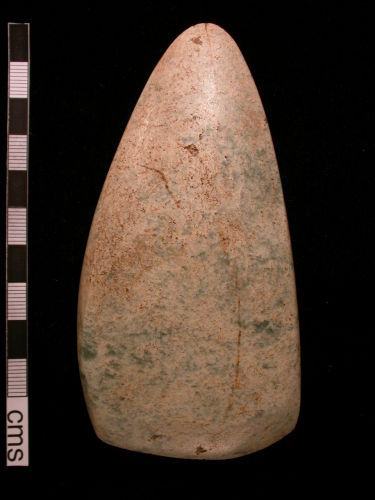
Rights Holder: Royal Institution of Cornwall
CC License: ![]()
Image use policy
Our images can be used under a CC BY attribution licence (unless stated otherwise).
AXE
Unique ID: CORN-71BC22
Object type certainty: Certain
Workflow
status: Published ![]()
Jadeite axehead, tear-drop shaped in plan and lozenge-shaped in profile and section, with patches of glassy polish and iron staining.
The axehead was analysed non-destructively, using scattered reflectance spectroradiometry, in October 2007 as part of an international French project, Projet JADE, covering all axeheads of Alpine rock in Europe. The project is directed by Dr Pierre Petrequin, until recently of CNRS and the University of Besancon. The analysis was undertaken by Dr Michel Errera (then of the Musée Royal de l'Afrique Centrale, Tervuren, Belgium) at the CNRS Laboratory at Le Frasnois in the Jura, France. Dr Errera compared the results with those for other Alpine axeheads, and for raw material specimens and working debris from the Alps.
The results confirm that it is indeed of a jadeite, from the Italian Piemonte. From the raw material samples that Dr. Errera has analysed, particularly one from Oncino, in the foothills of Mont Viso, in the North Italian Alps, offers a reasonable match. The shape of the axehead is interesting which may well result from the reworking of a larger original. There is only a restricted patch of glassy polish and the blade area lacks this high polish. Originally the parent piece may well have been detached from the outcrop or boulder by means of fire-setting, and then the roughout would have been sawn. The slightly stubby, truncated shape of this specimen makes sense in terms of modification from a larger original. Perhaps the parent boulder had been smallish and fully worked out, so that is why there are not several close matches among the many hundreds of axeheads that he has analysed. The axe is a type Puy which was the latest type to be manufactured and to travel a long distance, probably manufactured around 4000 BC but it may well have arrived in England in the first couple of centuries after 4000 BC." Information provided by Dr Alison Sheridan, the UK and Ireland Co-ordinator of Projet JADE, based at the National Museums Scotland.
Evidence of reuse: reshaped in antiquity
Subsequent actions
Subsequent action after recording: Returned to Landowner
Chronology
Broad period: NEOLITHIC
Period from: NEOLITHIC
Date from: Circa 4000 BC
Date to: 3800 BC
Dimensions and weight
Quantity: 1
Length: 116 mm
Width: 55 mm
Thickness: 10 mm
Discovery dates
Date(s) of discovery: Wednesday 1st January 1975
Personal details
This information is restricted for your access level.
Materials and construction
Spatial metadata
Region: East Midlands (European Region)County or Unitary authority: Lincolnshire (County)
District: North Kesteven (District)
Parish or ward: Potter Hanworth (Civil Parish)
Spatial coordinates
4 Figure: TF0867
Four figure Latitude: 53.189136
Four figure longitude: -0.385083
1:25K map: TF0867
1:10K map: TF06NE
Grid reference source: From a paper map
Unmasked grid reference accurate to a 1000 metre square.
References cited
No references cited so far.
Similar objects

Find number: WMID-CB9DF2
Object type: AXEHEAD
Broadperiod: NEOLITHIC
A stone axe dating from the Neolithic period. The axe has been ground from a fine grained igneous greenstone, probably from a volcanic ash dep…
Workflow: Awaiting validation![]()

Find number: CAM-36A859
Object type: AXEHEAD
Broadperiod: UNKNOWN
A fragment of stone, which has divided specialist opinion. It is not possible to confirm that this piece of stone is definitely an artefact a…
Workflow: Awaiting validation![]()

Find number: LEIC-F1DCAF
Object type: AXEHEAD
Broadperiod: NEOLITHIC
An incomplete Neolithic polished stone Axe, dating to c. 3450 - 2350 BC. The lithic is a polished volcanic stone probably from the Langdale r…
Workflow: Awaiting validation![]()






